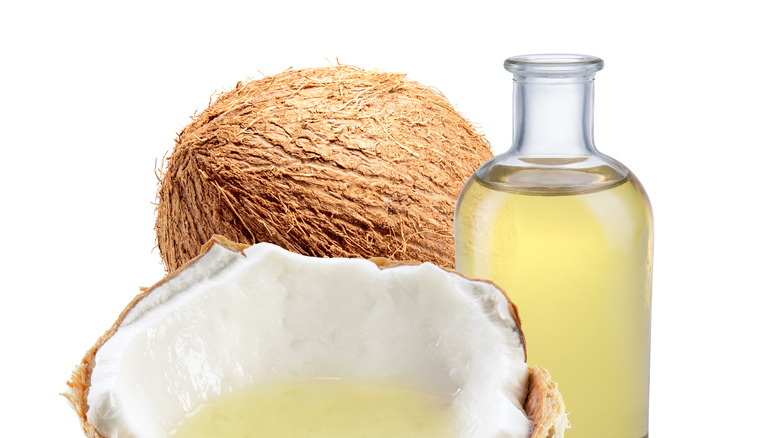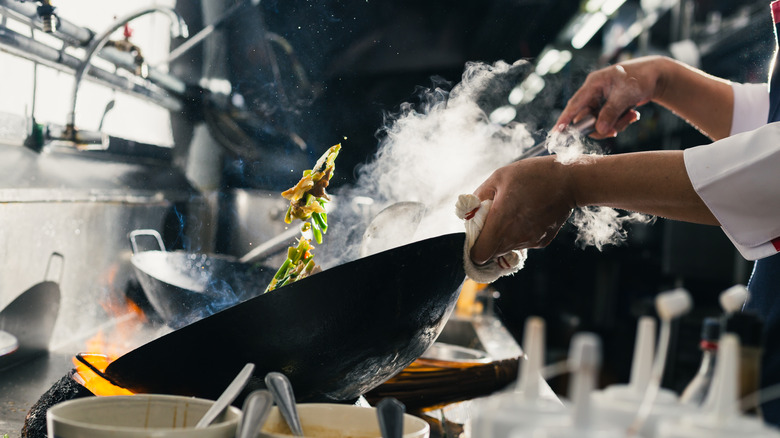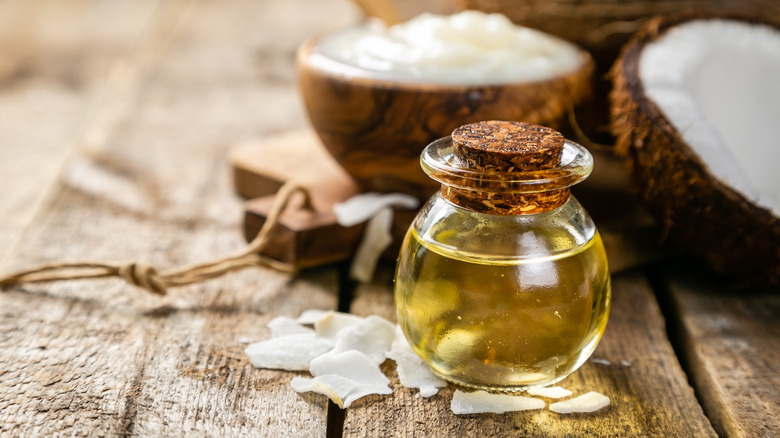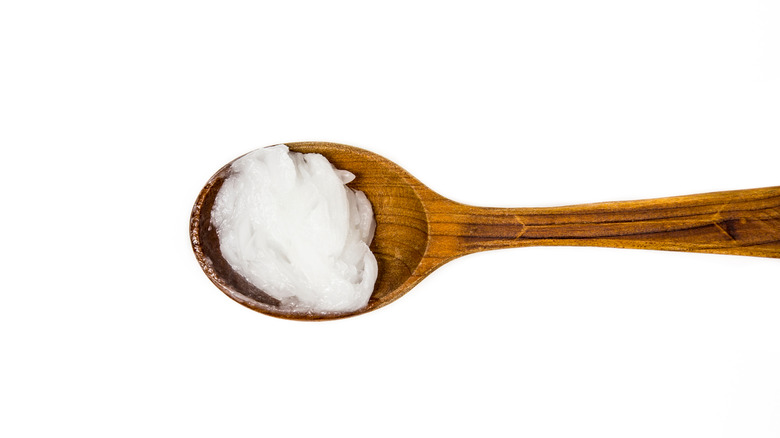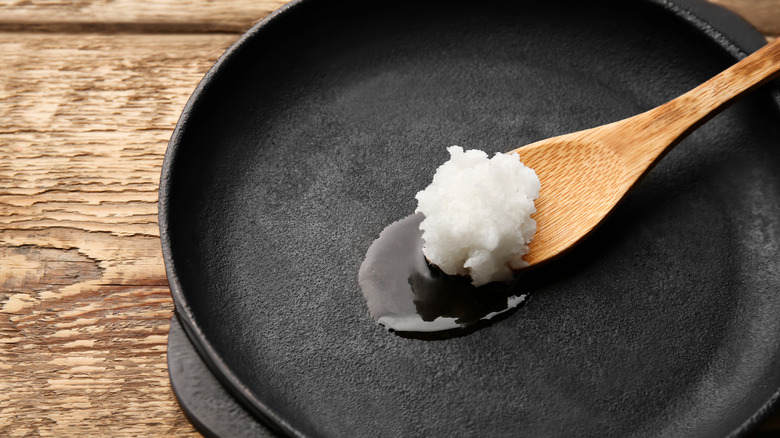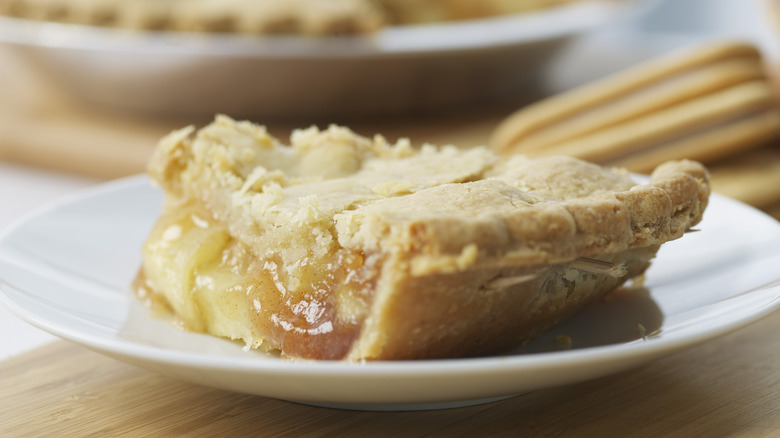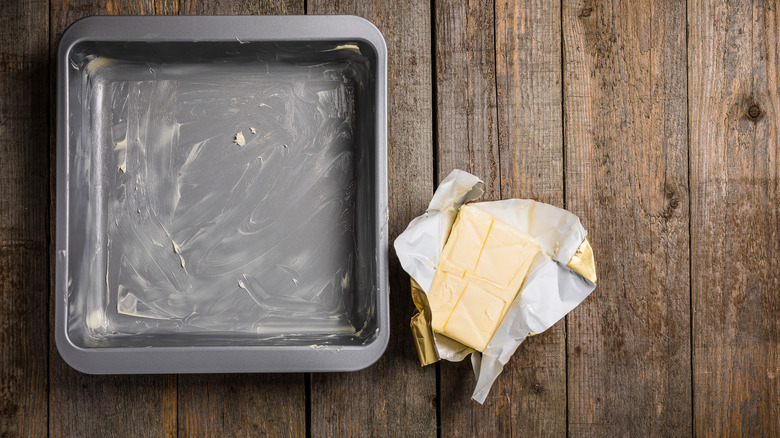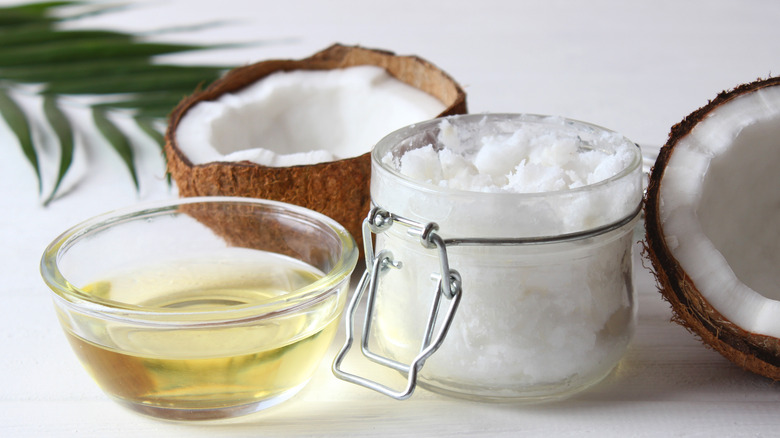Coconut Oil Cooking Tips You Need To Master
In the early 2010s, coconut oil became the "it" darling of the health food industry. From a natural substitute for body and hair products to a plant-based superfood, coconut oil enjoyed a bump in popularity that put the product on the radar of a lot more home cooks, as noted by the University of British Columbia. In truth, coconut oil has been a long-serving staple in countries in Asia and the Pacific Islands, including Sri Lanka. And while the "coconut craze" in western countries has largely leveled off, coconut oil has a permanent place in the pantry for many folks — especially those with dairy-free and plant-based diets.
As with most things in the kitchen, knowledge is power. And if you've had any prior experience cooking with coconut oil, you'll know that it doesn't behave exactly like other oils and fats. So whether you opt to use coconut oil for its flavor, characteristics, or your own dietary preferences, it can't hurt to get a bit more familiar with this unique and versatile ingredient. Here's a look at some key things to know about coconut oil if you plan to use it in your kitchen.
Be mindful of coconut oil's smoke point
If you've ever been confused by what a "smoke point" is and whether or not you should care about it, don't worry, you're not alone. Here's the gist of things: a smoke point describes the temperature at which the compounds in the oil begin to burn and — get this — smoke. It's basically the line in the sand, after which cooking oil overheats. While folks tend to get in a tissy about burnt oil's production of free radicals, as this article with The Washington Post underscores, this isn't a legitimate concern for most home cooks.
While the jury is still out on whether or not burnt food causes cancer (with Cancer Research stating this is "unlikely"), at the end of the day, it's best to exercise caution because coconut oil's smoke point is relatively low. Furthermore, the acrid taste of burnt food isn't going to win you any fans. The smoke point of unrefined coconut oil is 350 degrees Fahrenheit, which makes it ideal for baking and low and slow sautéing. If you want to cook on your stovetop at a higher heat, consider opting for an oil with a higher smoke point like peanut oil (450 degrees Fahrenheit) or Safflower Oil (510 degrees Fahrenheit).
Understand the difference between coconut and MCT oil
If you're a new or prospective convert to the world of coconut oil, you'd absolutely be forgiven for getting coconut and MCT oil confused. Both share similar characteristics and may share a shelf in the health foods section as they have become staples of the keto diet, which focuses on consuming fat and avoiding carbs. As Medical News Today explains, the top-level difference between the two oils is that coconut oil is made out of coconuts which naturally contain medium-chain triglyceride (MCT) whereas MCT oil is a concentration of MCTs. The fact that MCT oil is often derived from coconut oil adds to the confusion, as many manufacturers put coconuts on their branding. If you weren't paying close attention you could totally grab the wrong product.
While there are a bunch of differences between the two oils, the key difference is their intended purpose: MCT oil is more of a supplement, whereas coconut oil's applications are far more varied (and less focused on minimal fat storage). To boot, because MCT doesn't have as high of a smoke point as coconut oil (almost a 50°F difference), MCT oil isn't as ideal for cooking as coconut oil (via Healthline).
Remember to use in moderation
As noted by the BBC, there is no straightforward answer to the question, "Is coconut oil healthy for you?" Some folks tout the product as an energy-rich superfood, others have called it "pure poison." As a consumer and a home cook, it can be difficult to know who to listen to.
At the end of the day, unlike other plant-based cooking oils, coconut oil is almost entirely made up of saturated fat — which is what you are presumably using it for! That said, it's important to use a delicate touch when using any fat-based products in your cooking, and coconut oil is no exception. The American Heart Association recommends no more than 6% of your daily caloric intake come from saturated fat. So as long as you remember the overall context of your dietary habits (and you're not, say, spoon-feeding coconut oil into your mouth every night), you'll be just fine. As registered dietitian Liz Weinandy told Time magazine: "I am not anti-coconut oil ... our bodies do need some saturated fat. But the industry has done a good job to make it seem like it's a superfood. The research is definitely not there." As with most things, but especially with food, moderation is key ... as is being mindful of when a cure-all product sounds too good to be true.
Store your coconut oil properly
The nutrition website at Harvard University recommends ensuring that the conditions are cool and dark if you store your coconut oil in the pantry. A refrigerator is also an option, though let's be honest, most of us are looking for opportunities to free up real estate in whatever section of your fridge you store your condiments, pickled things, and miscellanea. The fridge isn't necessary, but if you're really worried about spoilage, it's definitely an option. Just be prepared for the product to be rock-solid.
As the folks at Harvard emphasize, storage is another instance where the refined versus unrefined process comes into play. While refined coconut oil (which is more pungent and made from fresh coconut meat) will last somewhere in the realm of a few months, the more processed alternative can last upwards of three years if it is stored correctly. To optimize freshness, MasterClass recommends cleaning utensils when interacting with the product to keep contaminating elements at bay.
If you're wondering how you can tell if your coconut oil has gone bad, one of the most obvious indicators is (you guessed it) mold. Our bodies are also a natural litmus test for spoilage. If your nose or your taste buds tell you something isn't right, you may have some expired coconut oil on your hands. Also, keep your eyes peeled for a yellow-tinged discoloration, which can mean that the product has turned rancid.
Get familiar with coconut oil's melting point
One of the key characteristics of coconut oil that distinguish it from other cooking fats is that it is solid at temperatures below 78 degrees Fahrenheit. This means that, when resting at room temperature, the oil will be solid, white, and opaque. On a warm day (or in a pan), the oil will liquefy. If during the melting process you notice little clumps of unmelted oil, do not panic.
As Now Foods explains, these little floating islands of solid coconut oil are crystallized saturated fats that are holding on for dear life just before they liquify. So if the solid oil is melting unevenly, don't worry. Unlike something like ice, fatty acids just don't melt in a uniform way. That means this 78 degrees Fahrenheit melting point is more of a loose approximation than a hard and fast rule.
As a home chef, the main thing to remember is that you can use coconut oil's unique melting point to your advantage: while liquid coconut oil is great for cookies or loaves, solid coconut oil is great in pie crusts. If you need to get your coconut oil to melt and you don't have a microwave (and don't want to melt it on your stovetop), you can put a bowl of solid coconut oil in a larger bowl containing boiling water, just like a double boiler.
Utilize coconut oil as a substitute
It's always a major bummer when you're getting your mise en place together for a recipe and you realize that you're missing a key ingredient. Luckily, a lot of ingredients can work as substitutes for each other. And if you ever find yourself in a pinch and need a neutral oil or fat, coconut oil might just come to your rescue.
Coconut oil's main superpower as a fat substitute in the kitchen seems to be primarily in a baking context. Coconut oil works great as a 1:1 replacement for canola oil, butter, and other fats used in baking. It is worth keeping in mind that, unlike butter or oil, if liquid coconut oil is added to cold wet ingredients like milk or eggs it will revert to its solid state.
As The Spruce Eats notes, you can use coconut oil over an open flame the same way you would butter. The danger here is that coconut oil has a much lower smoke point than other fats, which will cause it to burn faster if cooked over high heat. If you plan to pan-fry anything with coconut oil, definitely go the low-and-slow route.
Try coconut oil in pie crusts
If you follow a plant-based diet or if you're lactose intolerant, you might feel excluded from traditional pie crust recipes. If you're dead set on making your pie crust from scratch, you'll likely bump into dozens of recipes that use butter and shortening to add fat and moisture to the dough. And while other vegetable oils are totally legit, as The Spruce Eats notes, many oils can have strong flavors that don't always work with whatever pie filling you're using. While coconut oil might not gel with something like a quiche, there are plenty of pies that would benefit from a little hint of the tropical, vanilla-like flavor of unrefined coconut oil. The chocolate-crusted key lime pie from Disney World, perhaps?
As the blog Minimalist Baker underlines, the key to a flaky, dairy-free pie crust is the unique consistency of coconut oil's solid state. Unlike liquid oil alternatives, when the little solid chunks of solid coconut oil evaporate in the oven they create air pockets in the crust. And it's these little air pockets that make a pie crust taste flaky, as opposed to crunchy.
Use it to melt all your greasing needs
There's nothing quite like forgetting to grease a pan. After all that hard work, all you can do is stare your error in the face — spatula in hand, helpless against what has become a crispy, unpliable mess. And while you're frantically trying to scrape melted butterscotch off your "non-stick" baking sheet, consider how much easier your life could have been if you'd simply had a jar of coconut oil laying around.
Indeed, while its flavor profile might not be ideal for more savory culinary ventures, coconut oil is a great way to grease up baking sheets, pans, and tins. Just as you would with butter or shortening, dab a paper towel or a reusable cloth into the oil and spread a thin coat over the desired area. As noted previously, refined coconut oil is able to cook safely in the oven, which makes it a great option for greasing pans. To boot, if you're baking for someone plant-based or lactose intolerant, coconut oil is a solid choice. After all, no sense in doing all that work making a vegan chocolate chip cookie cake only to grease the pan with butter out of habit.
Understand the difference between unrefined and refined coconut oil
If the virgin versus non-virgin olive oil conundrum stresses you out, you may have been dismayed to find a similarly confusing distinction in the realm of coconut oil. But fear not — it's not that difficult to learn the difference. As Healthline explains, the key things that vary between these two different processes are the scent and flavor of the final product and their respective melting points. So, if you care about whether or not coconut oil will (or won't) make your food taste all coconut-y or if you want (or don't want) the coconut oil to act more like a liquid than a solid, it's worth learning the difference.
Unrefined (also called "virgin") coconut oil has a tropical smell and flavor, takes less heat to reach a liquid state (at 350 degrees Fahrenheit), and is made with fresh coconut meat. Think of it this way: because it's unrefined — and less has been done to it — virgin coconut oil tastes more like fresh coconuts. Meanwhile, as the name suggests, refined coconut oil has undergone further processing steps, which can range from deodorizing to degumming. Refined coconut oil has a neutral palette, requires more heat to melt (at 400 degrees Fahrenheit), and is typically made from dried coconuts.
